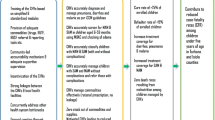Abstract
Purpose
We compared the impact of management of severe acute malnutrition (SAM) by lady health workers (LHWs) at a community level with the standard CMAM program provided at the health facility.
Methods
A two-arm cluster randomised controlled trial was conducted in a rural district in sindh Pakistan. The primary outcome was recovery from SAM and secondary outcomes were relapse, defaulter and mortality rate.
Results
A total of 829 children were recruited in the trial (430 in intervention and 399 in control groups). No significant difference was noted in recovery rate between the intervention and control groups (79.2% vs 85.6%, p = 0.276). Similarly, no significant differences were noted in relapse (p = 0.757), weight gain (p = 0.609), deaths (p = 0.775) and defaulter rate (p = 0.324) across the groups. Compliance of RUTF was significantly higher in the control group (93%) than in the intervention group (87%), p < 0.000.
Conclusion
Our results showed no impact of SAM treatment on performance indicators of CMAM (recovery, relapse, death and default) between the standard CMAM programme performed at the health facility by the government and NGO staff and the programme performed at health house level by the LHWs in Pakistan. We recommend further robust trials in other settings to confirm our results.

Similar content being viewed by others
References
UNICEF, WHO, World Bank Group (2015) Levels and trends in child malnutrition: UNICEF, WHO, World Bank Group joint child malnutrition estimates
Black RE, Victora CG, Walker SP et al (2013) Maternal and child undernutrition and overweight in low-income and middle-income countries. Lancet 382:427–451
World Health Organization (2010) Nutrition Landscape Information System (NLIS): Country Profile Indicators. Interpretation Guide, Geneva
UNICEF (2016) Levels and trends in child malnutrition: UNICEF/WHO/World Bank Group Joint Child Malnutrition Estimates
Government of Pakistan National Nutrition Survey (2011) Planning commission planning and development division. https://www.humanitarianresponse.info/en/operations/pakistan/document/national-nutrition-survey-2011. Accessed 12 February 2020
Bureau of Statistics Planning and Development Department, Government of sindh. Multiple Indicator Cluster Survey (2014). http://sindhbos.gov.pk/mics/. Accessed 24 March 2020.
Ahmed T, Hossain M, Mahfuz M et al (2014) Severe acute malnutrition in Asia. Food Nutr Bull 35:S14–S26
Park SE, Kim S, Ouma C, Loha M, Wierzba TF, Beck NS (2012) Community management of acute malnutrition in the developing world. Pediatr Gastroenterol Hepatol Nutr 15:210–219
USAID (2017) Community-based management of acute malnutrition: technical guidance brief. https://www.usaid.gov/what-we-do/global-health/nutrition/technical-areas/community-based-management-acute-malnutrition. Accessed 18 June 2020
Rogers E, Myatt M, Woodhead S, Guerrero S, Alvarez JL (2015) Coverage of community-based management of severe acute malnutrition programmes in twenty-one countries 2012–2013. PLoS ONE 10:e0128666
Akparibo R, Harris J, Blank L, Campbell MJ, Holdsworth M (2017) Severe acute malnutrition in children aged under 5 years can be successfully managed in a non-emergency routine community healthcare setting in Ghana. Matern Child Nutr 13:e12417
World Vision (2017) Community-based Management of Acute Malnutrition Model 2012. http://www.wvi.org/nutrition/project-models/cmam. Accessed 23 May 2020
UNICEF (2012) Evaluation of community management of acute malnutrition (CMAM): Pakistan country case study New York
Blanchet K, Roberts B, Sistenich V et al (2013) An evidence review of research on health interventions in humanitarian crises. Final Report, London
Bhutta ZA, Memon ZA, Soofi S, Salat MS, Cousens S, Martines J (2008) Implementing community-based perinatal care: results from a pilot study in rural Pakistan. Bull WHO 86:452–459
Soofi S, Ahmed S, Fox MP et al (2012) Effectiveness of community case management of severe pneumonia with oral amoxicillin in children aged 2–59 months in matiari district, rural Pakistan: a cluster-randomised controlled trial. Lancet 379:729–737
Sadler K, Puett C, Mothabbir G, Myatt M (2011) Community case management of severe acute malnutrition in southern Bangladesh. Boston Tufts University, Boston
Nishtar S (2006) The gateway paper; health system in Pakistan—A way forward. Pakistan’s Health Policy Forum and Heartfile, Islamabad
Zhu N, Allen E, Kearns A, Caglia J, Atun R (2014) Lady health workers in Pakistan: improving access to health care for rural women and families. Maternal Health Task Force, Boston
Action Against Hunger/ACF International (2013) Integrated SMART survey Dadu district, Sindh province
National Institute of Population Studies Pakistan and ICF International (2013) Pakistan demographic and health survey 2012–13. Islamabad
Donner A, Klar N (1996) Statistical considerations in the design and analysis of community intervention trials. J Clin Epidemiol 49:435–439
Ministry of Health (2009) National guidelines for the management of acute malnutrition among children under five and pregnant and lactating women. Islamabad
Somassè YE, Dramaix M, Bahwere P, Donnen P (2016) Relapses from acute malnutrition and related factors in a community-based management programme in Burkina Faso. Matern Child Nutr 12:908–917
Puett C, Guerrero S (2015) Barriers to access for severe acute malnutrition treatment services in Pakistan and Ethiopia: a comparative qualitative analysis. Public Health Nutr 18:1873–1882
Acknowledgements
We are thankful to the District and Provincial authorities of National Program for Family Planning & Primary Health Care, Lady Health Worker Program, Sindh, Pakistan for providing support to conduct this study
Funding
This study was supported by Innocent Foundation through Action against hunger (ACF) International.
Author information
Authors and Affiliations
Contributions
SBS conceived the idea and reviewed final manuscript. SC were involved in the field implementation of the trial. AR analysed the data. IH, AH and SA contributed in the development and revision of the manuscript. AH, SF, GNK, DK, JLA, SG and AG critically reviewed the manuscript. All authors reviewed and approved the manuscript.
Corresponding author
Ethics declarations
Conflict of interest
This is an original study and has not been published elsewhere, and all authors have no conflict of interest related to the study.
Rights and permissions
About this article
Cite this article
Hussain, I., Habib, A., Ariff, S. et al. Effectiveness of management of severe acute malnutrition (SAM) through community health workers as compared to a traditional facility-based model: a cluster randomized controlled trial. Eur J Nutr 60, 3853–3860 (2021). https://doi.org/10.1007/s00394-021-02550-y
Received:
Accepted:
Published:
Issue Date:
DOI: https://doi.org/10.1007/s00394-021-02550-y




